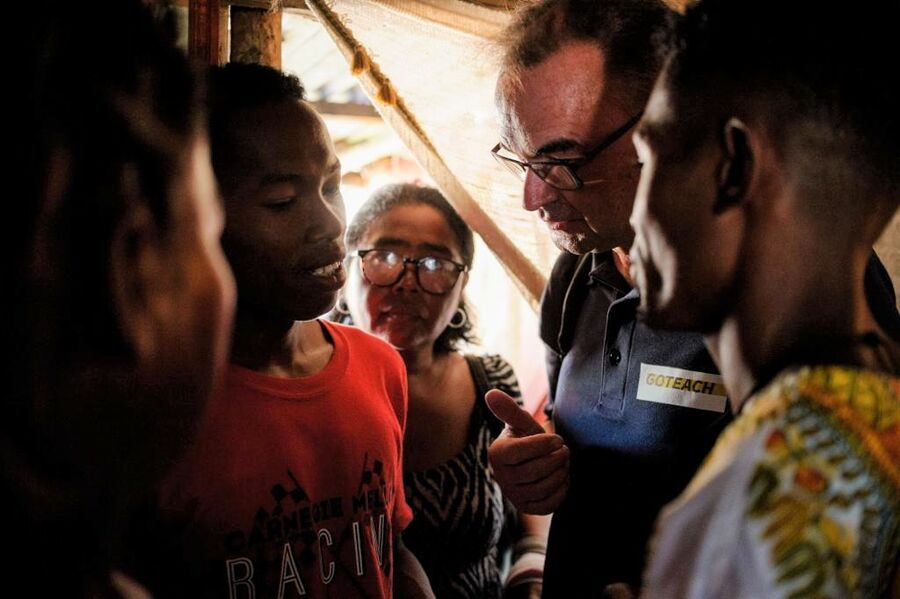No edit summary |
GoTeach Evaluation |
||
| Line 23: | Line 23: | ||
*Access to internship & employment opportunities | *Access to internship & employment opportunities | ||
<br /> | <br />What program participants say about GoTeach:{{Box|text="GoTeach has been more than just a program for me. I have come to understand the importance of perspective when it comes to life topics. Interacting with people from different backgrounds has allowed me to develop a different approach in problem solving and appreciate what I have."|Important=}} | ||
[[File:GoTeach group.jpg|center|900x900px|thumb|GoTeach in Madagascar - Young people consult with role models]] | |||
'''Teach For All GoTeach Evaluation Summary''' | |||
<u>Background</u> | |||
This evaluation was set up as an explorative study to learn the extent to which anticipated GoTeach outcomes matched students’ experiences. A non-experimental mixed-methods research design with post-intervention self-assessment measures was used. Researchers collected data using story-based inquiry, collecting both qualitative (narrative) and quantitative information among students. | |||
They studied the following evaluation questions: | |||
* Did the GoTeach partnership contribute to positive employability outcomes from students? | |||
* Are there any unexpected outcomes as a result of the GoTeach partnership? | |||
* Are there certain types of program activities that are most effective? | |||
<u>Key Findings</u> | |||
# Intensive activities yield the most outcomes. | |||
# Activities that achieved both personal and professional outcomes were ones where DHL volunteers shared their experiences with students. | |||
# Activity types aimed at both personal growth and employability generally yield both personal and professional outcomes. | |||
# Partnership activities focused on particular personal development topics are successful when developing self-knowledge skills. | |||
# GoTeach outcomes are acknowledged and relevant | |||
<u>Recommendations</u> | |||
* Increase the duration of the activity, or organize a series of activities for the same group of students and with regular time intervals. | |||
* Increase the relevance of the activities by including more skills training activities (such as CV writing, and job interview skills). | |||
* Adopt a more participatory approach for the partnership activities, specifically for online sessions, by making use of interactive tools, games, quizzes, etc. | |||
* Make sure that the nature of the activity and its anticipated personal and/or professional outcomes match with students’ interests and expectations, also taking into account their age and level of education. | |||
* Carefully think about the timing of the activity (e.g. close to major milestones in terms of educational/career planning). | |||
* Carefully think about how to select students for enrolling in the partnership, and whether enrollment should be voluntary or mandatory. | |||
Latest revision as of 15:34, 21 July 2023
3.2.1 GoTeach improves the employability of young people.
3.2.1.1 The program benefits its participants in various ways, as illustrate in the short summary below.
Outcomes for young people
- Young people know how to interact in a professional work environment
- Young people are self-motivated to take responsibility for their own future
- Young people have developed the necessary life/soft skills for employment
- Young people and their families have strong support networks and positive role models
- Young people are aware of their strengths and where they can develop
- Young people have improved their job hunting skills
Benefits for young people
- Increased self-confidence
- Self-motivation
- Sense of responsibility
- Professional skills & career guidance
- Access to internship & employment opportunities
What program participants say about GoTeach:
"GoTeach has been more than just a program for me. I have come to understand the importance of perspective when it comes to life topics. Interacting with people from different backgrounds has allowed me to develop a different approach in problem solving and appreciate what I have."

Teach For All GoTeach Evaluation Summary
Background
This evaluation was set up as an explorative study to learn the extent to which anticipated GoTeach outcomes matched students’ experiences. A non-experimental mixed-methods research design with post-intervention self-assessment measures was used. Researchers collected data using story-based inquiry, collecting both qualitative (narrative) and quantitative information among students.
They studied the following evaluation questions:
- Did the GoTeach partnership contribute to positive employability outcomes from students?
- Are there any unexpected outcomes as a result of the GoTeach partnership?
- Are there certain types of program activities that are most effective?
Key Findings
- Intensive activities yield the most outcomes.
- Activities that achieved both personal and professional outcomes were ones where DHL volunteers shared their experiences with students.
- Activity types aimed at both personal growth and employability generally yield both personal and professional outcomes.
- Partnership activities focused on particular personal development topics are successful when developing self-knowledge skills.
- GoTeach outcomes are acknowledged and relevant
Recommendations
- Increase the duration of the activity, or organize a series of activities for the same group of students and with regular time intervals.
- Increase the relevance of the activities by including more skills training activities (such as CV writing, and job interview skills).
- Adopt a more participatory approach for the partnership activities, specifically for online sessions, by making use of interactive tools, games, quizzes, etc.
- Make sure that the nature of the activity and its anticipated personal and/or professional outcomes match with students’ interests and expectations, also taking into account their age and level of education.
- Carefully think about the timing of the activity (e.g. close to major milestones in terms of educational/career planning).
- Carefully think about how to select students for enrolling in the partnership, and whether enrollment should be voluntary or mandatory.
| Chapter lead | Annette Wollmann |
|---|